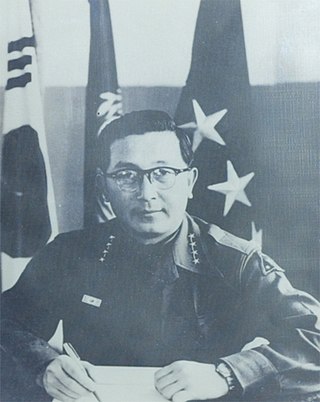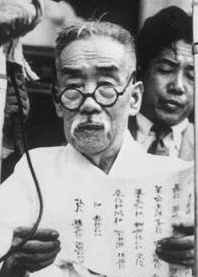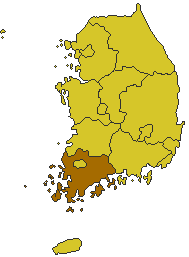
The Korean War was fought between North Korea and South Korea from 1950 to 1953. The war began on 25 June 1950 when North Korea invaded South Korea following years of hostilities between the two countries. North Korea was supported by China and the Soviet Union while South Korea was supported by the United States and allied countries. The fighting ended with an armistice on 27 July 1953.

Syngman Rhee was a South Korean politician who served as the first president of South Korea from 1948 to 1960. Rhee is also known by his art name Unam. Rhee was also the first and last president of the Provisional Government of the Republic of Korea from 1919 to his impeachment in 1925 and from 1947 to 1948. As president of South Korea, Rhee's government was characterised by authoritarianism, limited economic development, and in the late 1950s growing political instability and public opposition.

The division of Korea began with the 15 August 1945 official announcement of the surrender of Japan, thus ending the Pacific Theater of World War II. During the war, the Allied leaders had already been considering the question of Korea's future following Japan's eventual surrender in the war. The leaders reached an understanding that Korea would be liberated from Japan but would be placed under an international trusteeship until the Koreans would be deemed ready for self-rule. In the last days of the war, the United States proposed dividing the Korean peninsula into two occupation zones with the 38th parallel as the dividing line. The Soviets accepted their proposal and agreed to divide Korea.

The Jeju uprising, known in South Korea as the Jeju April 3 incident, was an uprising on Jeju Island from April 1948 to May 1949. A year prior to its start, residents of Jeju had begun protesting elections scheduled by the United Nations Temporary Commission on Korea (UNTCOK) to be held in the United States-occupied half of Korea, which they believed would entrench the division of the country. A general strike was later organised by the Workers' Party of South Korea (WPSK) from February to March 1948. The WPSK launched an insurgency in April 1948, attacking police and Northwest Youth League members stationed on Jeju who had been mobilized to suppress the protests by force. The First Republic of Korea under President Syngman Rhee escalated the suppression of the uprising from August 1948, declaring martial law in November and beginning an "eradication campaign" against rebel forces in the rural areas of Jeju in March 1949, defeating them within two months. Many rebel veterans and suspected sympathizers were later killed upon the outbreak of the Korean War in June 1950, and the existence of the Jeju uprising was officially censored and repressed in South Korea for several decades.

The April Revolution, also called the April 19 Revolution or April 19 Movement, were mass protests in South Korea against President Syngman Rhee and the First Republic from April 11 to 26, 1960, which led to Rhee's resignation.

Chung Il-kwon was a South Korean politician, diplomat, and soldier. A general in the Republic of Korea Army, he served as Foreign Minister 1963 to 1964, and Prime Minister from 1964 to 1970. He was an ally of President Park Chung Hee.

SeongjaeYi Si-yeong was a Korean politician, independence activist, educator and neo-Confucianist scholar. He was the first vice president of South Korea from 1948 to 1951. Yi resigned after the National Defense Corps incident of 1951. His nickname was Seongjae or Sirimsanin. Before the Japan–Korea Treaty of 1910, he had served for Joseon as the Governor of South Pyongan Province and the President of Hansung Law Court.
Kim Chang-ryong was a high-ranking officer in the Republic of Korea Army, the head of the Korean Counter Intelligence Corps, and South Korean President Syngman Rhee's most trusted right-hand man. He was assassinated in 1956 by army colleagues.

Ji Cheong-cheon, also known as Yi Cheong-cheon, was a Korean independence activist during the period of Japanese rule (1910–1945). He later became a South Korean politician. His name was originally Ji Seok-gyu, but he took the nom de guerre Ji Cheong-cheon, meaning "Earth and Blue Sky", while leading Korean guerrilla forces against the Japanese. To hide his identity from Japanese forces while conducting military independence activities, he also used the names Ji Dae-hyoung, Ji Su-bong, and Ji Eul-gyu. His pen name was Baeksan, meaning White Mountain.

Chough Pyung-ok was a South Korean politician. He ran against incumbent president Syngman Rhee in the 1960 presidential election but died on February 15, one month before the election on March 15. Rhee received 90% of the vote. He was the first Director of the Korean National Police from 1945 to 1949 and Minister of Home Affairs during the early stages of the Korean War.

Chang Myon was a South Korean statesman, educator, diplomat, journalist and social activist as well as a Roman Catholic youth activist. He was the only prime minister of the parliamentary Second Republic. In addition, during the First Republic he was the fourth and last vice president of South Korea. His art name was Unseok (운석). His English name was John Chang Myon.

The Bodo League massacre was a massacre and a war crime against communists and alleged communist-sympathizers that occurred in the summer of 1950 during the Korean War. Estimates of the death toll vary. Historians and experts on the Korean War estimate that between 60,000 and 200,000 people were killed.

Korea Military Academy (KMA) is the leading South Korean institution for the education and training of officer cadets for the Republic of Korea Army. Along with the Korea Army Academy (Yeongcheon), it produces the largest number of senior officers in the Korean army. Commonly referred to as Hwarangdae as a reference to the Hwarang, an elite organization of youth leaders which existed in Korean history, it is located in Nowon-gu, a northeastern district of Seoul, South Korea.

The Truth and Reconciliation Commission, established on December 1, 2005, is a South Korean governmental body responsible for investigating incidents in Korean history which occurred from Japan's rule of Korea in 1910 through the end of authoritarian rule in South Korea with the election of President Kim Young-sam in 1993.

The Yeosu-Suncheon rebellion, also known as the Yeo-Sun incident, was a rebellion that began in October 1948 and mostly ended by November of the same year. However, pockets of resistance lasted through to 1957, almost 10 years later.

Song Yo Chan was prime minister of South Korea from 3 July 1961 to 16 June 1962. Previously, he had been the head of the Ministry of Foreign Affairs and Trade from 22 July 1961 - 10 October 1961 and was a lieutenant general. He ordered the arrest of corrupt officers in the army. He had studied politics and economics at George Washington University in Washington, D.C. During the final days of the First Republic of South Korea of president Syngman Rhee, he declared martial law and forced the president to resign. Song Yo Chan refused to quell student-led protesters even though the police asked for bullets and troops. These protests are known as the April Revolution.

Shin Song-mo or Shin Sung-mo was an acting prime minister in 1950 following the first prime minister of South Korea, Lee Beom-seok. He served as a Defence Minister during the Korean War.

The Geochang massacre was a massacre conducted by the third battalion of the 9th regiment of the 11th Division of the South Korean Army between 9 February 1951 and 11 February 1951 of 719 unarmed citizens in Geochang, South Gyeongsang district of South Korea. The victims included 385 children. The 11th Division also conducted the Sancheong-Hamyang massacre two days earlier. The general commanding the division was Choe Deok-sin.
The Korean War was a major conflict of the Cold War and among the most destructive conflicts of the modern era, with approximately 3 million killed, most of whom were civilians. It resulted in the destruction of virtually all of Korea's major cities, with thousands of massacres committed by both sides—including the mass killing of tens of thousands of suspected communists by the South Korean government, and the torture and starvation of prisoners of war by the North Koreans. North Korea became among the most heavily bombed countries in history.
Ken Rhee is a South Korean former soldier, businessman, and broadcaster, best known for participating in the Russia-Ukraine War as one of the international volunteers supporting the Ukrainian side, and the resulting controversy in South Korea, where upon his return he was accused of violating the law.


















